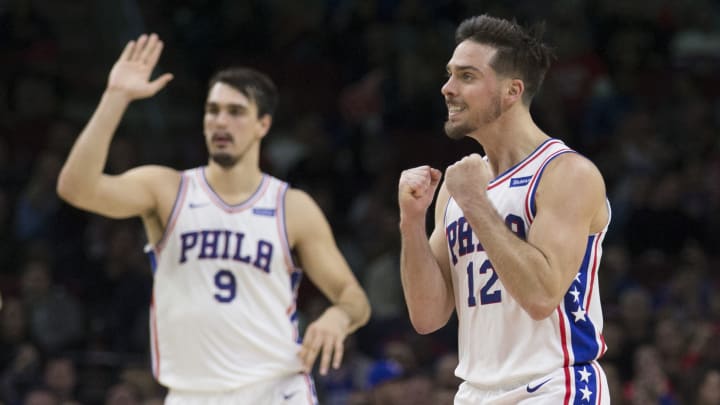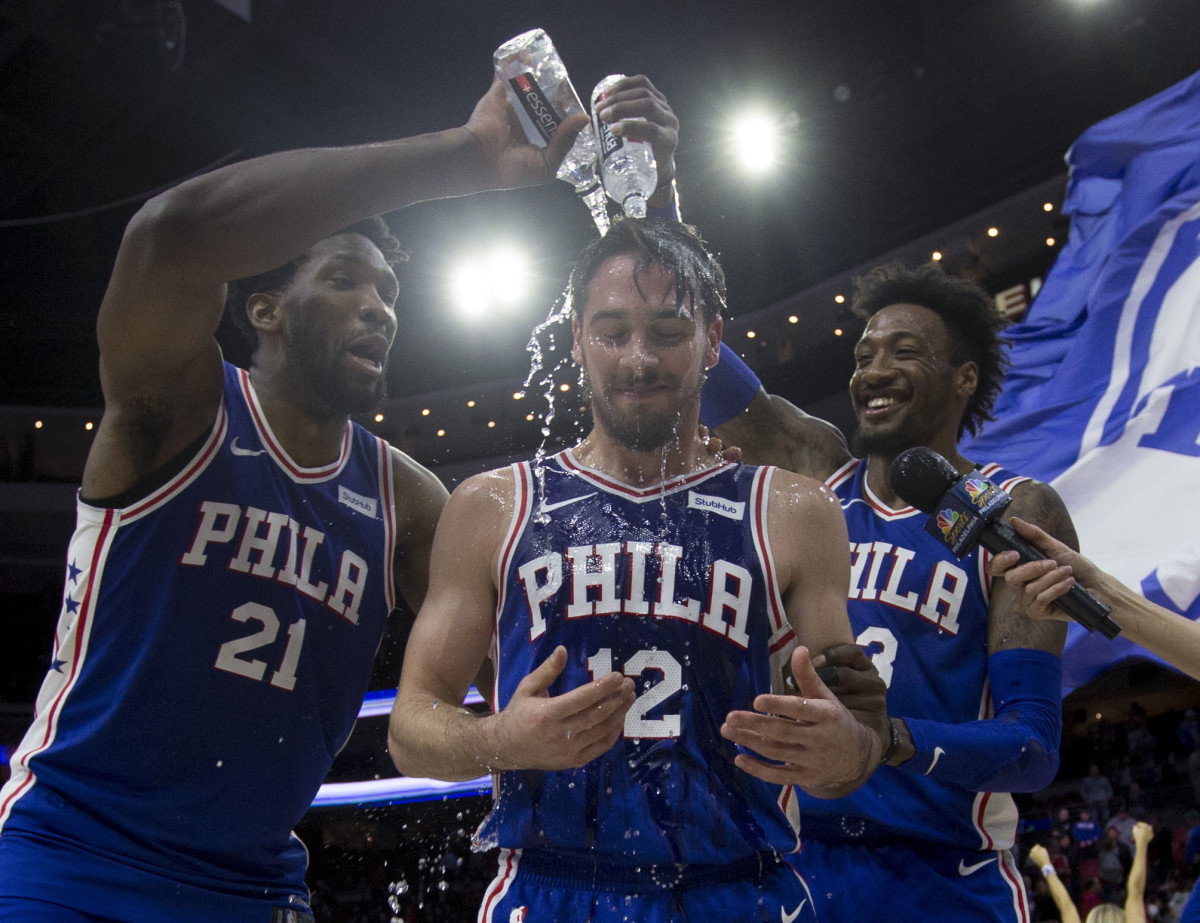How the 76ers' T.J. McConnell Morphed from Undrafted to Invaluable

Valerie Guiliani began on the street where she and T.J. McConnell grew up together. Tasked with a scavenger hunt around Pittsburgh, Guiliani followed a laundry list that ultimately spilled into Chartiers Valley High School’s main gym. Dozens of flowers blanketed the court and surrounded McConnell, kneeling alongside the couple’s new dog. There, McConnell asked his kindergarten classmate and longtime girlfriend to be his partner until death on the very hardwood that launched the journey of a lifetime.
How Instagram Conquered the NBA
McConnell still spends quite a bit of time sprawled on the floor. Myriad scabs and scars prove it. In a Feb. 12 game against the Knicks, McConnell crashed to the deck late in the first quarter when four New York defenders collapsed on his drive. He tumbled into the paint, fought off two pairs of interminable arms, regained his footing and somehow managed to unfurl a fading eight-foot jumper. The shot clanked short off the rim. Yet even after an exhaustive 10-second sequence—an eternity in NBA halfcourt offense—McConnell scurried back on defense, jumped a passing lane on the opposite sideline and rumbled into a now-open court, handing off to Sixers swingman Justin Anderson for an uncontested jam.
When Philly emerged with a 108–92 victory, McConnell boasted his first career triple-double, even adding six steals to his 10 points, 11 rebounds and 10 assists. “You really respect him,” Sixers head coach Brett Brown said postgame. “He just plays so hard. He’s a wonderful lesson for so many basketball players for what perseverance and toughness can bring you to."
Past the midway point of his third NBA season, McConnell has improbably blossomed into one of the premier backup point guards in the league, shooting 47.2% from three while posting 10.3 points, 6.5 assists, 4.7 rebounds and 2.0 steals per 36 minutes. “We’re talking about a guy who's totally eradicated the fact that he’s an average-or-lower athlete by NBA standards,” says two-time MVP Steve Nash.
A more traditional point guard playing style has ingratiated McConnell with the Phoenix Suns legend. “He’s a playmaker, he’s creative and skilled at taking up spaces to put pressure on the defense and create openings for his teammates,” says Nash, who harbors deep ties with the Sixers’ coaching staff. He teamed with Philly assistant coach Lloyd Pierce at Santa Clara and plays tennis with Chris Babcock, the development coach who helped McConnell remaster his shooting mechanics. Exposure to greatness has been a key ingredient to the Sixers’ rebuild. The staff took then-injured Joel Embiid to dinner with Kevin Durant and Stephen Curry when Philly visited the Warriors last March and he’s spent team-commissioned time with Kevin McHale. Shuttling McConnell to July workouts with Nash in Los Angeles was commonplace.

This wasn’t quite like Hakeem Olajuwon's fabled low-post laboratory, however. Nash’s private training infuses pliability exercises and dynamic, explosive movements into otherwise regimented on-court workouts, as if yoga and basketball molded an entirely different sport. McConnell would crouch, knees nearly bent at a 90-degree angle, dipping the ball almost a foot lower than his usual mechanics as Nash squatted even closer to the floor and repeatedly smacked the leather with both hands before McConnell rose into a jumper. He’ll position pupils at the foul line, instructing the shooter to balance on one leg before hunkering into their motion. Nash can then dissect how each muscle group, from your toes to your fingers, are utilized in each shot, breaking down a jumper by the nanosecond with the intricate, sequential detail of a flip book. “He said so much about your core and being low,” McConnell says.
Nash’s teachings are derived from the training regimen and exercises he first developed with Vancouver physiotherapist Rick Celebrini during the 2004 offseason. Having passed his 30th birthday, the point guard joined forces with Celebrini at the University of British Columbia, training on the court, in the gym, across forested trails and in the ocean to foster ample core strength that could overcome Nash’s spondylolisthesis, an aching back condition that causes vertebral slippage. “He’s like a big brother to me now,” Nash says.

Unexpectedly, Nash’s increased pliability not only preserved his body but unlocked a new degree of his skillset. “Any one percent gains are important gains when you’re at the NBA level,” he says. Nash morphed into the NBA’s MVP for the 2004–05 season and led the league in assists. He was now able to greater contort his body around bigger, burlier defenders in the paint and snake through the incessant pick-and-rolls that comprised Mike D’Antoni’s revolutionary offense in Phoenix.
“You’d be surprised how many very good NBA players have horrible positioning and horrible movement patterns,” Nash says. “They’re just explosive or ballistic, or long and skilled and talented. But I think just getting in a slightly deeper, more coiled and balanced position and staying there, having the endurance, the strategy to find it, to keep it and to move within those parameters are so beneficial to allowing your skills to be more efficient.”
Nash found his younger self in McConnell. “He sees the pictures, he uses those spaces well,” he says. But McConnell’s trademark, frenetic aggression that carved his niche in the league too often played into opposing defenses’ hands. He’d refuse open looks to zip the ball to a higher-scoring teammate. He would appear to calculate the Sixers’ best shot before actually analyzing what was in front of him. “When you play fast, a lot of times your decision making is also rushed,” Brown says.
Playing from a stronger, lower—in Nash’s words—deeper-coiled base allows players to greater capitalize on each movement and dribble—like McConnell’s hyperactive sequence against the Knicks. He has probed opponents with superior and varied pace this season. McConnell is now capable of providing a complementary threat to Ben Simmons in addition to running the second unit—his spot-up efficiency has skyrocketed from .734 points per 100 possessions in 2016–17 to 1.128 this season, per Synergy Sports. “How do you go from 40 to 60, back to 20, up to 100, controlling his gears, understanding time and score?” Brown says. “I think maintaining a poise of speed in his game and in his mind has been a progressive improvement.”
NBA Power Rankings: The Zombie Clippers Refuse to Go Away
McConnell’s engine is also roaring from different fuel. In close collaboration with the Sixers’ head chef, JaeHee Cho, he has eliminated the high-carb sandwiches and pastas that once dominated his diet at Arizona. “Bread’s amazing,” McConnell confesses. Cho has engineered a meal plan consisting mostly of chicken, fish and brown rice stir-frys, from a kitchen stocked with local, organic products, like meats from Swedesboro, N.J. and in-season produce from Green Meadow Farm in Gap, Penn. McConnell, and any Sixers player, can phone Cho day or night, peppering him with food-science questions, like the healthiest way to prepare a morning coffee at home.
The last ingredient to McConnell’s germination is more complicated than caffeine. After shooting a putrid 20% from three last season, the Sixers prioritized ironing the wrinkles in his jumper. Brown brought Babcock—the development coach who visited Nash with McConnell—with him to Philadelphia from San Antonio. Babcock spent a year learning under Spurs shooting czar Chip Engelland, who begins retooling players’ mechanics by examining their fingers. “I have different grips for different types of hands,” Engelland explains. “Different index finger lengths and different middle finger lengths, because it varies, kind of like ear lobes.”
Which NBA Draft Prospects Impressed During the Big Ten Tournament?
Babcock first shifted McConnell’s release more onto his fingertips, but placed greater emphasis on synchronizing the exact same release for every jumper. McConnell would previously raise the ball and jump with sporadic timing, depending on whether he pulled up off the dribble or was stationary along the perimeter. He now strolls onto the floor for pregame warmups and pokes Babcock to observe opponents who utilize a differing release with each repetition. Nash advised shooting every day and McConnell has obeyed. He lays on the couch and does flip drills at home and even journeys into the Sixers’ facilities on off-days, sometimes just for 15 minutes, to hoist jumpers. “Just trying to make that muscle memory,” McConnell says.
He's come a long way from May 2015, when he was studying for a final in his Tucson, Ariz., apartment as his agent, Chris Emens, rang. McConnell was the last invite to the NBA Draft combine. “I just flew across the United States pretty much and just tried to make a name for myself,” McConnell says. A low vertical jump and miniscule standing reach were just two of many humbling measurements. He never heard his name called that June 25. Even after the Sixers invited him to Summer League minutes following the 60th selection, Philly’s coaches grew increasingly skeptical McConnell even belonged on the Las Vegas court. Yet the Sixers are 34–28, good for sixth place in the Eastern Conference, with McConnell playing as their sixth man and Joel Embiid calling his backup point guard “THE GOAT”.
